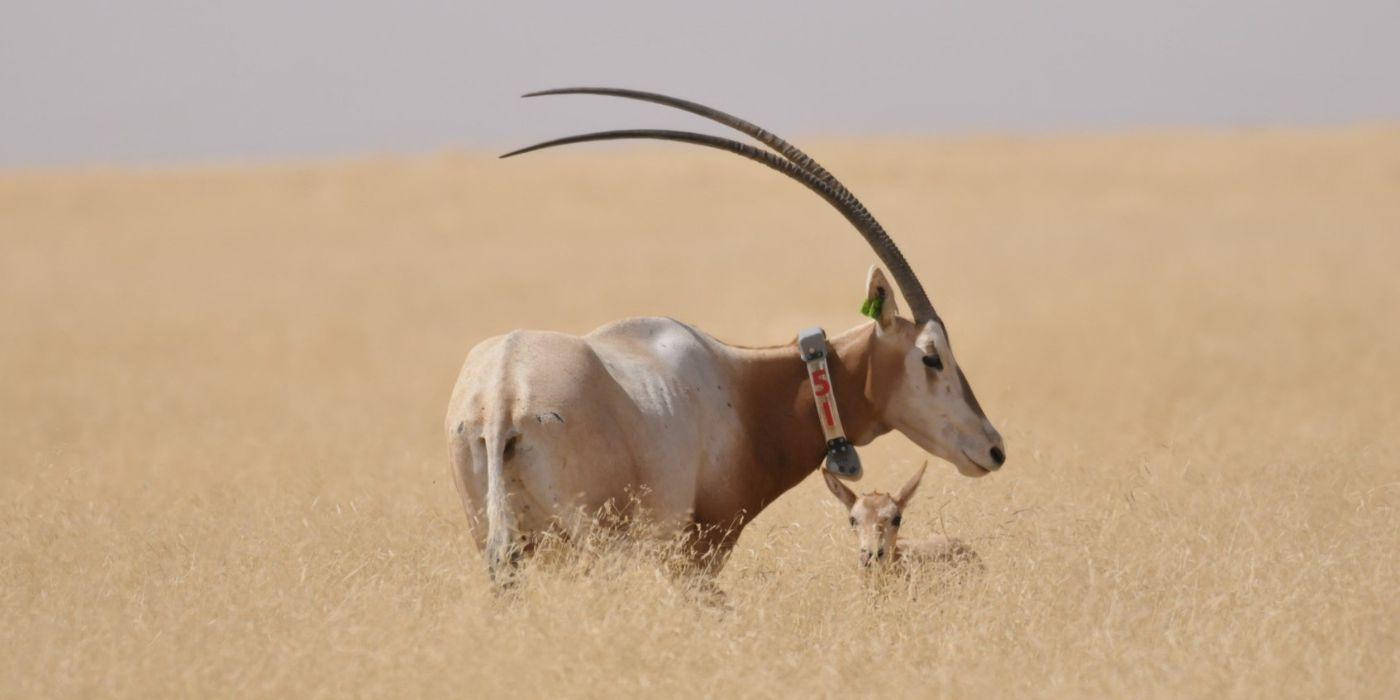The Weekly Anthropocene, December 4 2024
Nectar-eating wolves in Ethiopia, climate migration in PNG, a tiny frog in Brazil, scimitar-horned oryx recovery, solar in Chad, nocturnal pumas in LA, cleantech progress across America, and more!
Ethiopia
A fascinating new study has observed the rare Ethiopian wolf (Canis simensis) feeding on nectar from the Ethiopian red hot poker flower (Kniphofia foliosa) and transporting substantial qualities of pollen on their muzzles, making it a globally fascinating case where canids are potentially acting as pollinators. Extraordinary!
Japanese solar manufacturing company Toyo is currently building a 2 GW (2,000 MW) solar cell factory in the emergent city of Hawassa, Ethiopia, set to create up to 880 jobs. Production should start by April 2025, with plans to primarily serve the growing U.S. solar market1. Cleantech capacity continues to grow worldwide!
Papua New Guinea
In an impressive ongoing climate migration effort, 17 families from the low-lying and sea level rise-vulnerable Carteret Islands have voyaged to the much larger Bougainville. (All of these islands are currently part of Papua New Guinea, although Bougainville might become an independent nation as soon as 2027). Ten of those families, totaling 83 individuals, have founded a new village in Bougainville named Woroav, near which they’ve established a new forest of over 175,000 plants to preserve the biological richness of the Carteret Islands (including unique local varieties of breadfruit and taro). Spectacular work!
“We’re not just leaving. We’re trying to bring a part of our islands with us.”
— Maria Kamin, Carteret Islander
Brazil

A new species of amphibian smaller than a pencil eraser has been discovered in the Atlantic Forest of São Paulo State, Brazil. Brachycephalus dacnis is 6.95 millimeters long (less than one-third of an inch), making it one of the tiniest vertebrates anywhere in the world. Researchers found that it had retained the shape of its organs and skeleton while evolving its miniature size, and thanks to its delicate inner ear structures (key for balance) was able to jump 31 times its body length! Amazing.
A fascinating new study has found that Amazonian manatees (Trichechus inunguis) act as seed dispersers, with 556 viable seeds identified in 96 manatee fecal samples collected on the shores of Lake Amanã in Amazonas State, Brazil. This is a significant increase in humanity’s knowledge of these gentle creatures’ role in the Amazon ecosystem. Great work!
Chad
By the year 2000, the scimitar-horned oryx (Oryx dammah) was extinct in the wild, with the species surviving only in captivity after hunting had killed off the wild herds in North Africa. Then, in 2016, the first group of 21 oryx were released in the vast Ouadi Rimé-Ouadi Achim Faunal Reserve in Chad. Now, the wild oryx population is estimated to be nearly 600 individuals, with thousands more in captivity. Great work!

American solar company Convalt Energy is planning to build multiple solar projects for the government of Chad. An MOU was just signed to build three small community solar farms in the Chadian cities of Bongor, Lai, and Moundou, for a total of 3 MW of solar and 1.5 MWh of battery storage. For context, at the end of 2023 the entire country of Chad had just 2 MW of solar capacity! A much bigger 120 MW solar farm near the capital city of N’Djamena is reportedly in the works as well. Excellent!
Argentina
The menacing H5N1 bird flu strain that has scythed through wildlife worldwide in recent years devastated Argentina’s colonies of southern elephant seals (Mirounga leonina) in August 2023, causing populations to decline by as much as 66% in some areas. Now, researchers surveying the coast have found zero new cases of bird flu among the elephant seals, indicating that the outbreak is likely over and the colonies have begun the road to recovery. Good news!
United States
In the Greater Los Angeles area, a new study tracking 22 radio-collared pumas (aka cougars or mountain lions) has found that individual pumas are becoming more nocturnal. This helps them better coexist with local human populations, especially in parks with lots of outdoor recreation activity. Notably, the pumas of Los Angeles and the leopards of Mumbai are the only two cases on Earth where a city of over 10 million people is home to wild big cats - so far!
“This is a very optimistic finding. I think that we can be really appreciative of the flexibility of mountain lions in the timing of their activity and how that supports them using the same spaces as people.”
— Ellie Bolas, lead author
On November 21, 2024, renewables developer RWE and coal company Peabody Energy announced a landmark new partnership to build ten new solar power and battery storage projects on former coal mining lands in Illinois and Indiana. These 10 projects will total 5.5 GW (5,500 MW) of electricity-generating capacity, enough to power over 850,000 homes in the region. Excellent work!
The Biden-Harris Administration continues to accelerate U.S. cleantech investments, with several major BIL and IRA-funded Energy Department Loan Projects Office funding guarantees finalized recently. This industrial policy funding has broad sector-wide catalyzing effects; over $1 trillion of private investment has now been directed to American industry under President Biden. Here are four big-deal major highlights!
On December 2, 2024, the LPO announced a conditional commitment to loan up to $7.54 billion to StarPlus Energy (a Stellantis and Samsung joint venture) to build two new lithium-ion EV battery factories in Kokomo, Indiana. This project will create over 2,800 operations jobs, reduce emissions, reduce reliance on China, and produce enough batteries to supply 670,000 vehicles per year!
On November 25, 2024, the LPO announced a conditional commitment to loan up to $4.9 billion to build the Grain Belt Express, a 2,500-megawatt high-voltage power line planned to stretch 578 miles from west-central Kansas to east-central Missouri. This project will bring Kansas clean electrons to lower costs for Missouri consumers, reduce emissions, and strengthen U.S. grid resilience and connectivity!
On November 25, 2024, the LPO announced Project Polo, a conditional commitment to loan up to $289.7 million (~$0.29 billion) to Sunwealth to deploy new virtual power plants by building up to 1,000 new solar and battery storage projects across 27 states! This project is set to reduce emissions and create about 3,700 jobs.
And in November 2024, the LPO announced Project Horizon, a conditional commitment to loan up to $6.57 billion to U.S. EV maker Rivian to build a new electric SUV factory in Georgia. This project will make up to 400,000 vehicles, boost the U.S. EV manufacturing sector, reduce emissions, and create 7,500 operations jobs by 2030!
Self-driving car company Waymo has begun a new multi-year partnership with Hyundai to produce specially modified Ioniq 5 electric SUVs at the Hyundai factory in Georgia2 for use as Waymo self-driving taxis. Notably, available data indicates that Waymo’s self-driving cars are substantially safer than human drivers, with the first 7.1 million miles driven in San Francisco, Los Angeles, and Phoenix causing only 3 minor injuries compared to an expected 13 injuries for human drivers. Future Waymo taxis will now be American-made all-electric vehicles. Great news!
Startup Kairos has won legal approval to build two experimental salt-cooled nuclear reactors at their test site in Tennessee, in another win for the small but influential U.S. “nuclear renaissance.”
With federal approval of a revised plan, New York City may finally implement pollution-reducing congestion pricing starting in January 2025.
The New York Times reports that the United States government is building an early warning system for geoengineering, with an in-progress network of weather balloons carrying sensors built to detect any attempts to release sunlight-reflecting aerosols in the stratosphere to combat global warming.
Infamous fossil fuel giant ExxonMobil and Korean chemistry titan LG Chem have signed a non-binding deal advancing a plan to supply up to 100,000 metric tons of lithium carbonate from Exxon Mobil’s project at a lithium deposit in Arkansas to LG Chem’s EV battery cathode factory in Tennessee. This is a great example of why the cleantech revolution appears unstoppable: there’s a whole lot of money to be made!
Notably, Ethiopia is currently exempt from U.S. solar tariffs, making this investment a data point in favor of renowned economist Substacker Noah Smith’s hypothesis that President Biden’s tariffs on Chinese and Southeast Asian solar products will help spread industrialization to other developing countries.
A totally different EV factory in Georgia, not related to the Rivian one. Georgia, and the U.S. Southeast as a whole, is becoming a major electric vehicle manufacturing hub.










So exciting to see the scimitar-horned oryx back in the wild! Also thank you for the news on the adorable tiny, tiny, teensy little frog. I needed that adorableness in my day.
I love and appreciate your work.